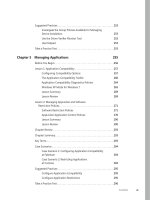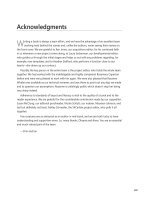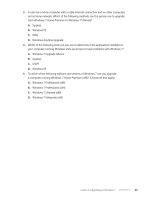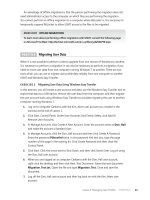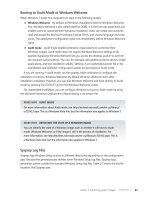22 hypertrophy training progression part 3
Bạn đang xem bản rút gọn của tài liệu. Xem và tải ngay bản đầy đủ của tài liệu tại đây (449.71 KB, 11 trang )
UNIVERSITY
Hypertrophy
Training
Progression Part 3
The Lesson
PART I
Programming a Training Block
Understanding Progressive Overload
Volume Load Progression as a Gauge of Progress
PART II
How to Progress Reps and Load
How to Progress Effort
How to Progress Set Volume
Autoregulating Set Additions
PART III
Lift Progression Trouble Shooting
Progression During Contest Prep
Progression During a PED Blast or Cruise
Lift Progression Trouble shooting
The more advanced you are less progress session to session you
will make. Progress on just one lift is a win for the day.
What if most lifts are progressing except a few?
1. Might just need more time to work the lift, I would give it 3
sessions before rotating it out.
2. Also try varying loading week to week to try to drive up the
lift. So if hitting 400lbs x 10 reps every week, Jump to 440 x 6
reps one week, then the next week back to 405lbs and try to
match or beat the reps.
3. Double check to make sure its just not an off session and
sleep, hydration, nutrition, stress all need to be on point. So
don’t write off one lift if maybe you just lost some stamina in
the session.
Lift Progression Trouble shooting
I progressed my first lifts, but my other lifts dropped off in
performance?
1. Large jumps in performance on first lifts might lower
performance on subsequent lifts from greater fatigue. This
can be acceptable, but make sure you trend upward on all
lifts over the training weeks.
2. You might not progress on your first set, but progress on the
second set. This is common using top and back off sets and
acceptable progression.
3. Double check to make sure its just not an off session and
sleep, hydration, nutrition, stress all need to be on point. So
don’t write off one lift if maybe you just lost some stamina in
the session.
4. Did you decrease your rest times between sets?
Lift Progression Trouble shooting
I progressed my first lifts, but my other lifts dropped off in
performance?
5. Evaluate that first lift and make sure the progression wasn’t
based on changing mechanics, ROM, or bar speed.
6. Progressing a lift is sign adaptation has occurred, but some fatigue
might be accumulating quickly, if you see a persistent drop off in
performance might be time for a deload or a few lower volume
training sessions.
7. If all sessions are getting lengthy and fatigue is getting high at the
end of sessions might be time to progress up to the next training
split to manage stimulus and fatigue.
Lift Progression Trouble Shooting
All lifts have stopped progressing?
1. Are you nailing sleep 7-8 hours , nutrition (calorie
surplus), stress management? If no, then nail all these
variable and see if progress ensues.
1. I am nailing all the above variables! Are you motivated to
train or dreading the gym? Is your PRS score <4? Load and
reps are decreasing? Aches and pains higher? Sleep poor
or Hunger less?
1.
2.
If YES to 2 or more of the above, you are likely not recovering and
need a deload and if this occurs again in less than 3 weeks you
need to train with a lower volume amount.
If NO to all questions or yes to only 1 item you are recovering but
it might be time to increase training volume via adding sets or
moving up a training frequency tier.
**Managing Fatigue and Deloads will be in our next lectures!
Lift Progression Trouble Shooting
Adding sets when not progressing and recovery is great?
1. Make sure technique is not the limiting factor. Most weak body
parts are held back by poor set quality and doing more sets is not the
answer.
2. If technique is solid add sets across a few lifts that cover all body
parts. If you are advanced, you might start with a couple body parts
first. More advanced might favor isolation movement set additions
over multi joint to manage fatigue or running PPL specialization cycles
to focus volume on one body part.
3. If stalled on just one body part start with a set addition just for that
body part.
4. Go slow as a set addition is a large stimulus, a 10-20% increase in
set volume is a starting point. So if doing 10 sets of chest move up to
11 sets for a few weeks.
Progressing During Cutting/Prep
During contest prep overload training will be limited and slower due to
lower recovery capacity.
Continue to train the SAME as you did in the offseason. What made
you grow is what will keep muscle on.
Do NOT lessen your effort in the sets, this is what is making you sets
stimulating.
This is NOT the time to add in more sets, unless your recovery is
phenomenal.
Your goal regardless is to attempt to progress the stimulus.
Part of prep may end up being a drop in performance for some this
won’t happen (via PEDs). But in Fatigue Management we will learn
how to manage fatigue to keep training hard.
Progression with PED Usage
Progress can be enhanced at a faster rate, still follow the same
progression model and add sets if recovery is very high.
Caution! Rate of strength increase can exceed rate of connective tissue
strengthening so be reasonable on rapid load only progressions.
All other topics from this lecture apply the same to natural or a PED
user.
Coming off cycle, may decrease recovery capacity you will simply train
a within a volume level you can recover from and still attempt to
progress your lifts.
For advanced PED users cruise periods might be closer to maintenance
at best and lower volume and frequency's can be used but keep sets
HARD!!
Summary
• Progressive Overload is a way to keep pace with an adaptation, so
training remains stimulating for growth.
• Our main progression tool is increasing load and reps to ensure our
sets remaining stimulating for growth.
• Dynamic Double Progression is the system to use to move up in load
and reps week to week.
• Stalls in lifts can be evaluated using recovery markers and
determining if more or less training is needed.
• During dieting phases training will remaining the same but we will
use fatigue management strategies to keep training effective.
• PED users and naturals can train the same; the 2 things that change
will be rate of progress and required volume levels.
References
Beardsley, C. Hypertrophy: Muscle fiber growth caused by mechanical
tension. Strength and Conditioning Research Limited, 1 edition; 2019.
Baz-Valle, E.N., Fontes-Villalba, M., Santos-Concejero, J., Total Number
of Sets as a Training Volume Quantification Method for Muscle
Hypertrophy: A Systematic Review. J Strength Cond Res, 2018.
Schoenfeld B. Science and Development of Muscle Hypertrophy.
Champaign, IL: Human Kinetics; 2021.
Minor, B., Helms, E., Schepis, J. Re: Mesocycle Progression in
Hypertrophy Volume Versus Intensity. J Strength Cond Res, 2020. doi:
10.1519/SSC.0000000000000581


